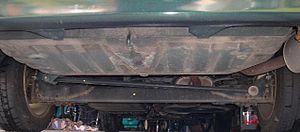- Beam axle
-
A beam axle is a suspension system, also called a solid axle, in which one set of wheels is connected laterally by a single beam or shaft. A live axle is a type of beam axle in which the shaft (or shafts, since live axles, while connected to move as a single unit, are seldom one piece) also transmits power to the wheels; a beam axle that does not also transmit power is sometimes called a dead axle. Beam axles are commonly used at the rear wheels of a vehicle, but historically they have also been used as front axles in rear wheel drive cars. Ford used beam axles across the range until 1949, only being phased out in Europe as recently as the early 1960s with the Ford Popular being suspended (though the 100E was fitted with MacPherson struts).
Beam axles are typically suspended either by leaf springs or coil springs. In some cases, a Panhard rod or similar device may be used to control the lateral motion of the axle.
A similar suspension is the Twist-beam rear suspension, in which the beam axle also functions as an anti-roll bar to control the roll motion of the body.
The principal advantage of the beam axle is that it is simple and cheap to manufacture. It also engages little or no interior volume within the vehicle. Its drawbacks are that it does not allow each wheel to move independently in response to bumps, and the mass of the beam is part of the unsprung weight of the vehicle, which can further reduce ride quality.
Because beam axles do not ever exhibit any camber change as the suspension travels, they are ideal for carrying heavy or varying loads. Although this negatively impacts cornering compared to other suspension designs (because the wheels have zero camber gain during body roll), beam axles are nearly universally used in heavy-duty trucks. One notable exception is the Czech manufacturer Tatra, who instead use swing-axles in conjunction with a central 'backbone' chassis. Most light and medium duty pickup trucks and vans also use a beam axle, at least in the rear.
Beam axles have an important advantage for off-road applications, as they provide better vehicle articulation and durability in a high load environment.
 Solid axle suspension characteristics: Camber change on bumps, none on rebound, large unsprung weight
Solid axle suspension characteristics: Camber change on bumps, none on rebound, large unsprung weight
Beam axles are nonetheless common on low-cost, front-wheel drive cars, particularly minivans and other vehicles placing a great emphasis on maximum internal volume.
Categories:- Automotive suspension technologies
Wikimedia Foundation. 2010.

